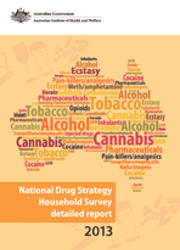Summary
The 2013 National Drug Strategy Household Survey collected information from almost 24,000 people across Australia on their tobacco, alcohol and illicit drug use, attitudes and opinions.
In July 2014, the AIHW released key national findings from the survey which showed:
- Smoking—a significant decline in daily smoking between 2010 and 2013 (from 15.1% to 12.8%); younger people are delaying the take up of smoking; and smokers reduced the average number of cigarettes smoked per week.
- Alcohol—fewer people in Australia drank alcohol in harmful quantities in 2013; the proportion of young people abstaining from alcohol rose; and there was a decline in alcohol-related victimisation.
- Illicit use of drugs—declines in use of some illegal drugs in 2013, including ecstasy, heroin and GHB; while meth/amphetamine use did not increase, there was a change in the main form used with ice (or crystal methamphetamine) replacing powder; and there was a rise in the misuse of pharmaceuticals.
This report builds on the key findings and presents more detailed analysis including comparisons between states and territories and for other population groups.
2 in 5
people in Australia smoked tobacco, drank alcohol at risky levels or used an illicit drug.
In 2013, just over 40% of Australians either smoked daily, drank alcohol in ways that put them at risk of harm or used an illicit drug in the previous 12 months; 3.1% engaged in all 3 of these behaviours.
People living in Remote and Very remote areas
were twice as likely as people in Major cities to smoke daily, drink alcohol in risky quantities, and use meth/amphetamines in the previous 12 months.
Certain groups disproportionately experience some drug-related risks. People in the lowest socioeconomic status group, the unemployed, people who live in Remote and Very remote areas, and Indigenous Australians continue to be more likely to smoke daily than other population groups. Meth/amphetamine use was highest among people in Remote and Very remote areas and those people were twice as likely to have used meth/amphetamines as people in non-remote areas. Use of illicit drugs in the last 12 months was far more common among people who identified as being homosexual or bisexual, although as a group their drug-taking behaviour did not change between 2010 and 2013.
The drug-use patterns in states and territories generally reflect national trends.
Declines in daily tobacco smoking were statistically significant in New South Wales, Victoria and Western Australia. The proportion of daily smokers in the Northern Territory (22%) was more than double the proportion in the Australian Capital Territory (9.9%).
Patterns of risky drinking varied across jurisdictions, for example, people in the Northern Territory and Western Australia were more likely to consume alcohol in quantities that placed them at risk of an alcohol-related disease, illness or injury.
Similar to the national trend, there were no significant changes in illicit drug use for any jurisdiction.
Summary
1. Introduction
2. Overview
3. Tobacco smoking in the general population
4. Alcohol use in the general population
5. Illicit use of drugs
6. Misuse of pharmaceuticals
7. State and territory comparisons
8. Specific population groups
9. Policy and attitudes
10. Explanatory notes
Appendix A: Membership of the Technical Advisory Group
End matter: Acknowledgments; Abbreviations; Symbols; Glossary; References; List of tables;



